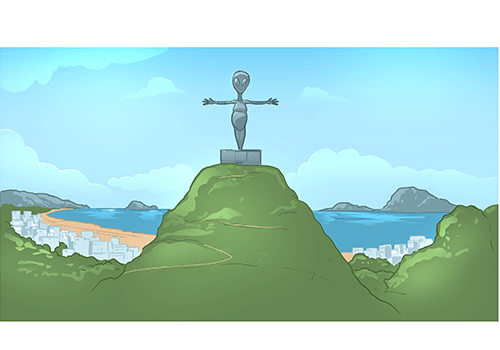Portuguese
Língua portuguesa
Língua portuguesa
about 220 million
Brazil (185 million), Portugal/Azores/Madeira (11 million), Angola (60 thousand), Mozambique (30 thousand), Cape Verde (25 thousand), East-Timor, Equatorial Guinea, Guinea-Bissau, São Tomé and Principe, Macau, EU
Paraguay (750,000), South Africa (617,000), Uruguay (28,000), Goa (250,000)
France (750,000), US (365,000), Canada, Switzerland, Belgium, Germany (about 80,000 each), Luxembourg (50,000), Venezuela


From a tiny corner of the Iberian Peninsula, Portuguese was spread far and wide by the ships of its sea-borne empire. On their way to Far-Eastern riches the Portuguese naus established trading posts and forts along the coasts of Africa, in India (Goa), China (Macao) and along strategically important shipping lines (Cabo Verde, East Timor). However, 90% of the sailors died on each trip, and no large population transfer occurred. In its more immediate neighbourhood, Portugal settled the Azores and Madeira, both now with their own dialects, and the islands were important bridge heads for further expansion. The real masterstroke of the Portuguese expansion was, however, Brazil, which became a melting pot of Indian, Portuguese and - thanks to a ruthless and large-scale slaving trade - African genes. In the process, the Portuguese language, European diseases and the bandeirantes slave captains decimated thousands of Indian languages, with only one serious competitor, the Tupi-based Lingua Geral, which was widely used in the Amazon area for a few hundred years. Today, the vast majority of Portuguese speakers are Brazilians, and where printing presses were once banned by royal decree, telenovela soap operas have now inversed the cultural flow between Portugal and its former colony.
Migration period
Visigoth influence
Moorish invasion
Arabic influence
Independent Portugal
Language of lyrics
End of reconquista
First Portuguese university
Madeira
Azorean islands
Calcutta, India
Cabral-expedition: Brazil
Goa (India)
Macao (China)
Union with Spain
Pombaline reform period
Napoleonic invasion, royal court moved to Brazil
Brazilian independence
Decolonization wars in Africa Exodus of millions of Portuguese
Like its Romance sister languages, Portuguese has undergone a number of systematic sound changes during its evolution from common Latin roots. However, though lexically closest to Spanish, Portuguese is more akin to Italian and Catalan in terms of vowels, having retained the original Latin vowels where Spanish and French introduced diphthongs.
Portuguese uses the ordinary Latin alphabet, but includes ç and allows accents on vowels. These accents are not simply stress markers, but have phonetic value.
Portuguese orthography is quite regular, and in most cases (standard) pronunciation can be predicted from the written word. The language has a high vowel/consonant-ratio, a trait that is emphasized in Brazilian Portuguese which has enslaved itself to an iambic-syllabic rhythm even to the point of inserting extra vowels in consonant clusters in the spoken language, e.g. pi-si-co-lo-gi-a instead of psicologia (psychology). In Portugal, on the other hand, the vowels are weakened to such a degree that the result sounds like an incomprehensible slur of consonants to Brazilian ears, e.g. Frnandpssoa instead of Fer-nan-do Pe-sso-a (a famous poet). Needless to say, the more rhythmic Brazilian variant has fostered a vibrant dancing culture, while the mournful and drawn melancholy of Portuguese fado is more inclined to induce weeping rather than dancing.
| Male | Female | |
|---|---|---|
| the black horse | the round table | |
| Singular | o cavalo preto | a mesa redonda |
| Plural | os cavalos pretos | as mesas redondas |
Portuguese has 3 regular conjugations (-ar, -er, and -ir), e.g. falar (talk), comer (eat) and dormir (sleep), as well as several dozen irregular verbs or verb groups. A semi-irregular feature is a vowel shift between root-stressed and endings-stressed forms, and between dark (a/o) and light (e/i) vowel endings.
| Root-stressed | Ending-stressed | |
|---|---|---|
|
dormir
sleep
|
durmo
I sleep
|
dormimos
we sleep
|
| Dark-vowel ending | Light-vowel ending | |
|---|---|---|
|
consentir
agree
|
consinto
I agree
|
consente
he/she agrees
|
|
comer
eat
|
Singular | Plural | ||||
|---|---|---|---|---|---|---|
| 1st person | 2nd person | 3rd person | 1st person | 2nd person | 3rd person | |
| Indicative | ||||||
| Present | como | comes | come | comemos | comeis | comem |
| Imperfect | comia | comias | comia | comíamos | comíeis | comiam |
| Preterite | comi | comeste | comeu | comemos | comestes | comeram |
| Pluperfect | comera | comeras | comera | comêramos | comêreis | comeram |
| Future | comerei | comerás | comerá | comeremos | comereis | comerão |
| Subjunctive | ||||||
| Present | coma | comas | coma | comamos | comais | comam |
| Imperfect | comesse | comesses | comesse | comêssemos | comêsseis | comessem |
| Future | comer | comeres | comer | comermos | comerdes | comerem |
| - | ||||||
| Conditional | comeria | comerias | comeria | comeríamos | comeríeis | comeriam |
| Imperative | come | (coma) | (comamos) | comei | (comam) | |
| Personal infinitive | comer | comeres | comer | comermos | comerdes | comerem |
In addition, the following compound tenses can be formed with the auxiliary ter (have), with examples in the first person singular:
| Indicative | Subjunctive | |
|---|---|---|
| Compound perfect preterite | tenho comido | tenha comido |
| Compound pluperfect | tinha comido | tivesse comido |
| Future perfect | terei comido | tiver comido |
| Compound conditional | teria comido | - |
Portuguese is not a compounding language, allowing only prefixes (e.g. hiper- "hyper") and suffixes (e.g. -ização "-ization"), but not root compounding. Therefore, the longest words in the language are scientific words with Greek or Latin roots (chemistry, medicine, sociology).
Deeply rooted in European Portuguese, are many Arabic words from over 500 years of Islamic rule and the reconquista. These words are often recognizable from their initial 'al-' (the Arabic article).
The Portuguese were at a linguistic loss when confronted with Brazilian nature and tens of thousands of animal, plant and place names were borrowed from Indian languages, first and foremost Tupí and its Jesuit-regularized version Lingua Geral.
The food and religion of Angolan slaves have become an essential part of the Brazilian soul, contributing cultural icons such as feijoada (bean stew) and exu (spiritistic daemon).
Portuguese has only 2 written standards used for teaching, European (Lusitan) Portuguese and Brazilian Portuguese, comparable to the orthographical-lexical split between British and American English, but also featuring some grammatical differences. The dialectal landscape of spoken Portuguese, however, is very varied in terms of accents and lexicon. There are 10 main dialect areas in Portugal and its islands. Among Portuguese dialects in Spain, Galician is prominent and sometimes considered a separate language for political reasons. In Brazil, dialects carry many lexical traces of Indian and African languages, as well as other European immigrant languages. In all corners of the former Empire, Portuguese dialects remain. The current revival of Portuguese in Angola and Mozambique is backed by a strong standardisation effort detrimental to the dialects. Finally, there is a number of surviving Portuguese creoles, that are not dialects, but languages evolved from Portuguese trading pidgins: Kabuverdiano (Cape Verde), Forro (São Tomé & Principe) and Papiamento (Dutch Carribean ABC islands).













